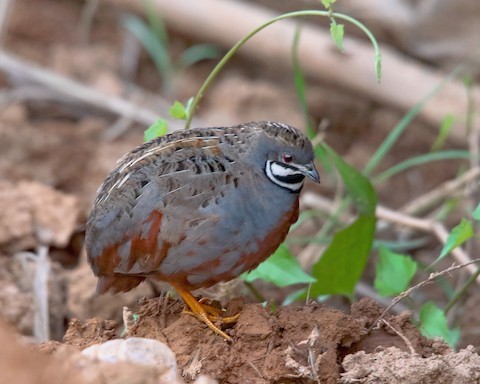Birdfinding.info ⇒ Uncommon, local, shy, and difficult to find across most of its large range. It also appears to be somewhat nomadic, appearing at a site for a few weeks, months, or years, then disappearing. A few sites where it seems to occur consistently include: the Bengal Florican Reserve in central Cambodia; the Chuping Planation in Perlis, Malaysia; the Bislig Airport on Mindanao, Philippines; the Numundo Ranch on New Britain; and in Australia at Lake Samsonvale near Brisbane, Limeburners Creek Nature Reserve near Port Macquarie, and Hexham Swamp Nature Reserve near Newcastle, New South Wales.
King Quail
Synoicus chinensis
Southern Asia to Australia, where it is widespread, but declining and now absent from large portions of its former range.
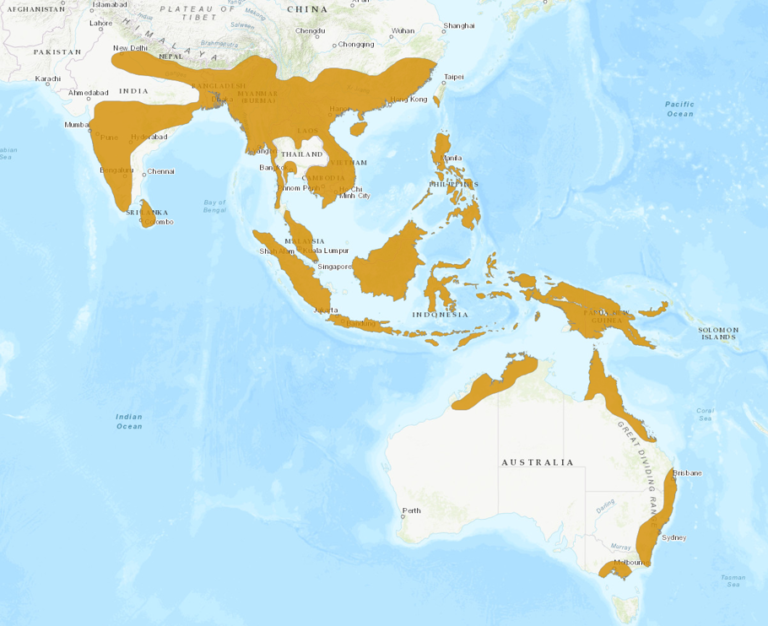
Approximate historical range of the King Quail. © BirdLife International 2016
Occurs in various grassy habitats, generally favoring damp areas. Mainly in lowlands, but locally up to 2,000 m elevation.
In southern Asia, patchily distributed from eastern India (West Bengal and Assam) and Bangladesh east to southernmost China (Guangxi), and south through Indochina to Singapore. Also on Sri Lanka and very locally or sporadically in southwestern India (coastal Karnataka and Kerala).
Formerly recorded much farther west in India (to Haryana and Gujarat) and east in China (to Fujian) and to southwestern Taiwan.
Still widely distributed across the Philippines, Indonesia, New Guinea, and New Britain, but apparently localized or sporadic on many of these islands.
In Australia, it occurs in three regions: (1) the Kimberleys and northern Northern Territory; (2) the coastal lowlands from Queensland to central New South Wales; and (3) the central coastal lowlands of Victoria, where reportedly introduced.
Introduced populations are established on Réunion and Guam—and formerly also on Mauritius.
Identification
The smallest of all quails: sparrow-sized and plump.
Male is extensively grayish-blue (sometimes appears vivid blue), with brown shading and black spots on the upperparts, and largely chestnut from the mid-breast to the vent.
Has a striking and complex black-and-white pattern on the throat.
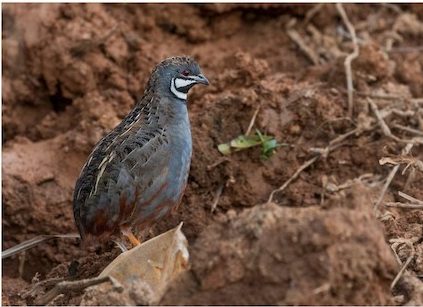
King Quail, male. (Kenjar Wetlands, Mangalore, Dakshina Kannada, Karnataka, India; March 28, 2019.) © Arnold Goveas

King Quail, male showing extensively chestnut breast and belly. (Kenjar Wetlands, Mangalore, Dakshina Kannada, Karnataka, India; April 6, 2019.) © Harshith JV

King Quail, male, photographed at night with a spotlight. (Borneo Jungle Girl Camp, Sabah, Malaysia; April 25, 2015.) © Wayne Hsu

King Quail, male in flight. (Numundo, New Britain; October 3, 2014.) © Frédéric Pelsy
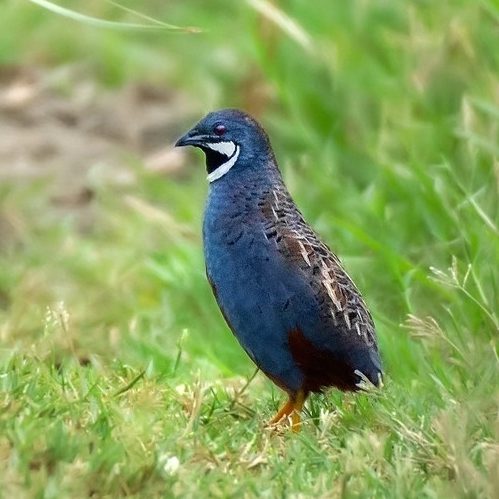
King Quail, male, showing very little chestnut on underparts. (Baruipur, South 24 Parganas, West Bengal, India; July 14, 2019.) © Prasenjit Bhattacharjee

King Quail, male. (Baruipur, South 24 Parganas, West Bengal, India; July 29, 2019.) © Abhishek Das
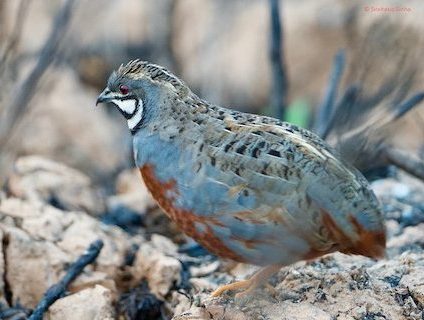
King Quail, male, showing mottled pattern on upperparts, including the crown. (Kenjar Wetlands, Mangalore, Dakshina Kannada, Karnataka, India; April 6, 2019.) © Snehasis Sinha
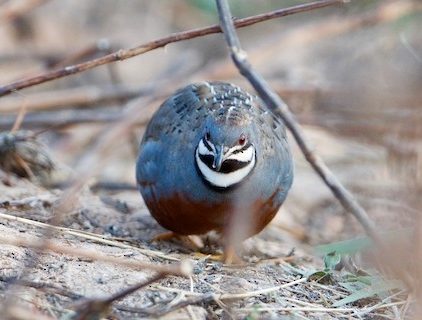
King Quail, male showing complex black-and-white pattern on throat. (Kenjar Wetlands, Mangalore, Dakshina Kannada, Karnataka, India; April 6, 2019.) © Snehasis Sinha
Female’s plumage is cryptically mottled with brown, buff, black, and white. The head is typically a warm orangey shade of buff, and the middle of the breast and belly are mostly unmarked and whitish.
The female’s most distinctive feature is well-defined blackish barring on the chest, sides, flanks, and vent.
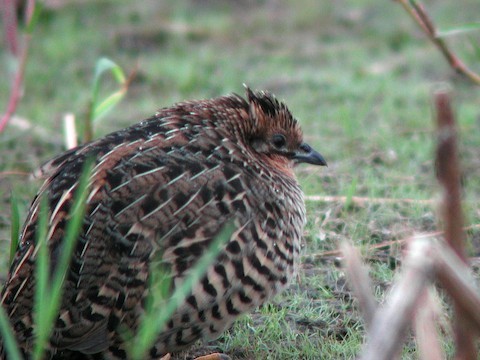
King Quail, female showing heavily barred sides. (Lake Samsonvale, Moreton Bay, Queensland, Australia; October 17, 2004.) © Tom Tarrant
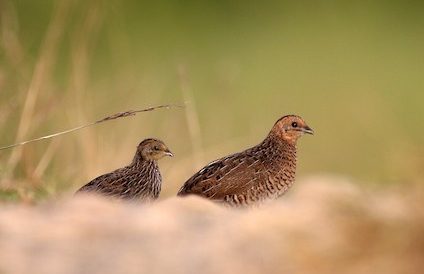
King Quail, female (at right) with chick. (Bato, Leyte, Philippines; July 27, 2017.) © Anre Kuizon

King Quail, female showing barred side and white mide-breast and belly. (Penang, Pulau Pinang, Malaysia; August 12, 2019.) © Dave Bakewell
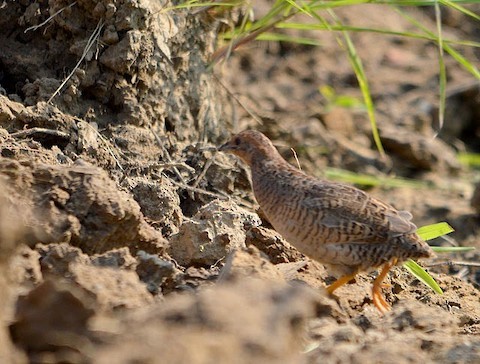
King Quail, female showing extensive barring from chest to tail. (Chuping Plantation, Perlis, Malaysia; January 17, 2015.) © Choy Wai Mun

King Quail, female. (Lake Samsonvale, Moreton Bay, Queensland, Australia; March 15, 2017.) © Marie Tarrant
In flight, the female’s wings appear uniform brown—which can distinguish it from some similar species that sometimes occur with it.
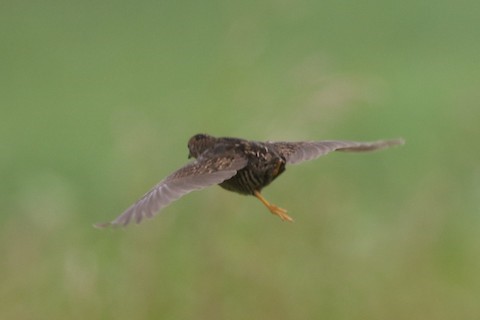
King Quail, female—note plain-brown wings and barred flanks. (Lake Samsonvale, Moreton Bay, Queensland, Australia; December 27, 2019.) © Rick Franks
Voice. Male’s typical advertising call is a whistled ti-tu!: Sometimes gives a three-syllable version, ti-ti-tu!:
Notes
Polytypic species consisting of ten recognized subspecies. Sometimes considered conspecific with the Blue Quail (S. adansonii) of Africa—although they are obviously close relatives, the plumage differences are pronounced and consistent, so this treatment seems incorrect.
Quail of Many Names. The King Quail is plagued by nomenclatural ambiguity, as it has five English names and three scientific names in widespread use. Besides King, it is sometimes called Blue-breasted, Asian Blue, Chinese Painted (mainly among aviculturists), or simply Blue (when lumped with its African relative). Besides Synoicus, it has also been placed in the genera Coturnix and Excalfactoria.
The name King Quail has the virtues of tradition, dignity, and irony to recommend it. The male is truly regal in plumage, even if minuscule in stature. The interests of individuation and identity seem to support continued use of the name King, particularly given that the main alternatives (Blue-breasted and Asian Blue) are somewhat inaccurate—as King and its African counterpart both have varying amounts of blue and chestnut on the breast (so “Blue-breasted” is misleading), and King’s range extends far beyond Asia into Australasia (so “Asian Blue” is not quite right).
References
BirdLife International. 2016. Synoicus chinensis. The IUCN Red List of Threatened Species 2016: e.T22678979A92797212. https://dx.doi.org/10.2305/IUCN.UK.2016-3.RLTS.T22678979A92797212.en. (Accessed March 17, 2020.)
Brazil, M. 2009. Birds of East Asia. Princeton University Press, Princeton, N.J.
eBird. 2020. eBird: An online database of bird distribution and abundance. Cornell Lab of Ornithology, Ithaca, N.Y. http://www.ebird.org. (Accessed March 16, 2020.)
Madge, S., and P.J.K. McGowan. 2002. Pheasants, Partridges, and Grouse: A Guide to the Pheasants, Partridges, Quails, Grouse, Guineafowl, Buttonquails, and Sandgrouse of the World. Princeton University Press, Princeton, N.J.
McGowan, P.J.K., and G.M. Kirwan. 2020. Asian Blue Quail (Synoicus chinensis). In Handbook of the Birds of the World Alive (J. del Hoyo, A. Elliott, J. Sargatal, D.A. Christie, and E. de Juana, eds.). Lynx Edicions, Barcelona. https://www.hbw.com/node/53439. (Accessed March 17, 2020.)
Robson, C. 2002. Birds of Thailand. Princeton University Press, Princeton, N.J.
Xeno-Canto. 2020. King Quail – Excalfactoria chinensis. https://www.xeno-canto.org/species/Excalfactoria-chinensis. (Accessed March 17, 2020.)
